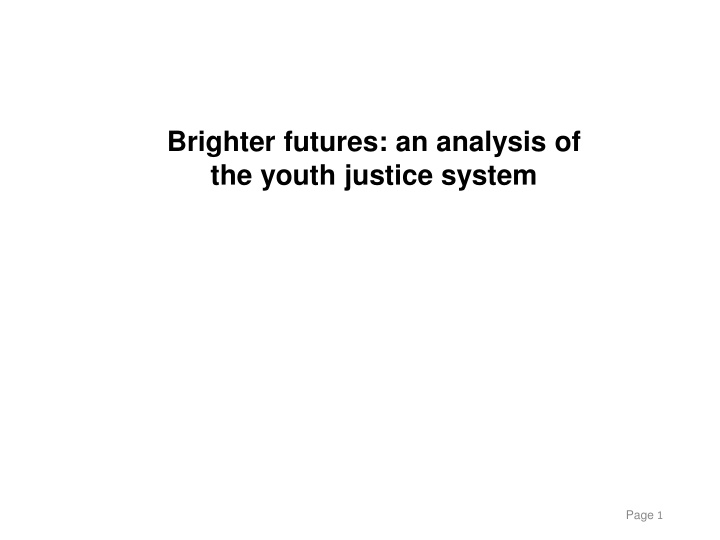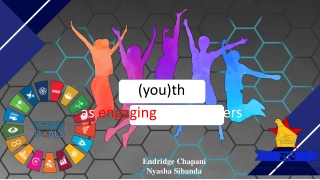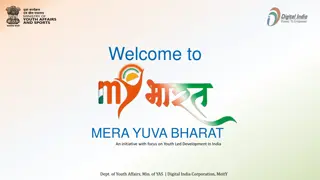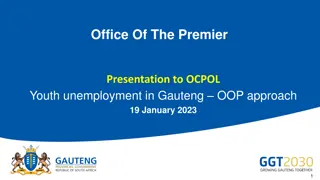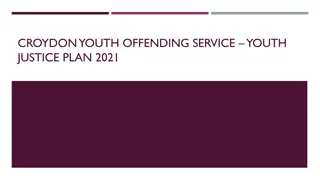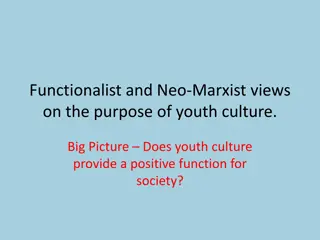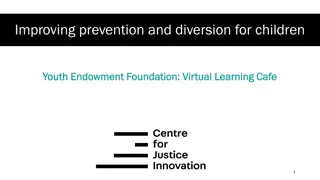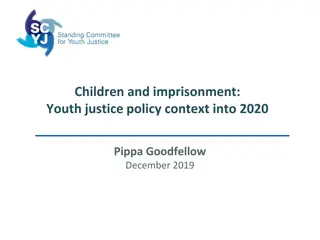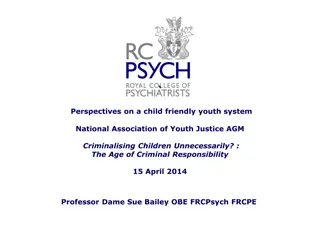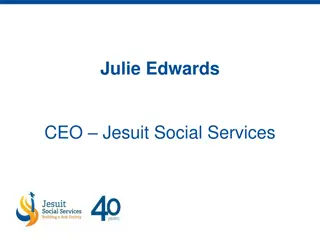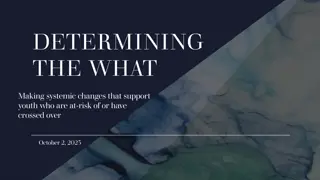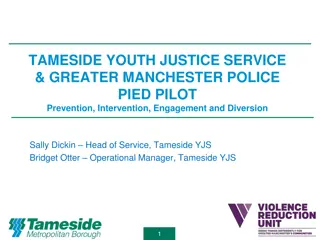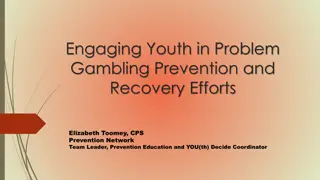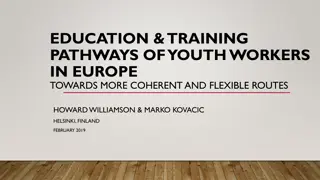Analysis of Youth Justice System
The Youth Justice Board (YJB) conducted a comprehensive analysis of the youth justice system with input from various stakeholders to identify strengths, limitations, and areas for improvement. Through workshops and consultations, evidence-based themes were explored to support children in transitioning to positive lives free from offenses. The presentation showcases feedback, ideas for change, and patterns emerging from the discussions.
Download Presentation

Please find below an Image/Link to download the presentation.
The content on the website is provided AS IS for your information and personal use only. It may not be sold, licensed, or shared on other websites without obtaining consent from the author.If you encounter any issues during the download, it is possible that the publisher has removed the file from their server.
You are allowed to download the files provided on this website for personal or commercial use, subject to the condition that they are used lawfully. All files are the property of their respective owners.
The content on the website is provided AS IS for your information and personal use only. It may not be sold, licensed, or shared on other websites without obtaining consent from the author.
E N D
Presentation Transcript
Brighter futures: an analysis of the youth justice system Page 1
Acknowledgements The Youth Justice Board (YJB) extends its gratitude to the 250+ stakeholders who came together to help us to create a map of the youth justice system (YJS) and for their ideas to support system improvement. Thanks also goes to Dr. Kate Williams for her contributions throughout the process, including providing external validation of our analysis and Dr. Luke Billingham for his support and advice on our final product. We also take this opportunity to extend special thanks to each and every YJB Ambassador, without whom this process would never have come to life it is our privilege to work with you. We hope that this presentation reflects the many and varied voices of the YJS and will help our partners shape their future activity and business planning.
The concept As part of our statutory duty to maintain oversight of the youth justice system we invited stakeholders to consider its current strengths and limitations. This in-depth look at the system doesn t always make for comfortable reading but does reflect a desire to do the best for children, victims and communities and provides an important source of evidence. We purposefully didn't limit conversations and ideas for change to what is possible within current budget, resource, legislation or wider culture. Therefore, some ideas should be recognised as suggestions for potential longer-term change. We have reflected this throughout the presentation through ordering the content within the patterns and ideas for change from societal/systemic change to operational.
The concept How did we gather evidence? Between October 2021 and February 2022, the YJB hosted a series of workshops with our partners. Attendees ranged from children with experience of the system to youth justice practitioners to charities to government departments. Attendees considered what the evidence tells us is the most impactful way to help children in contact with the system move onto positive, offence-free lives. This was benchmarked against four evidence-based themes of what works. From those workshops, we produced a system map of the YJS for England and Wales and have analysed the content. This deep consultation provides qualitative evidence of the current strengths and limitations of the system.
Reading notes This presentation provides an externally-validated analysis of both written and verbal feedback shared during our partner workshops. Additionally, within this presentation, we share with you some of the attendees ideas for change. Underlying patterns slides 6 and 7 provide a summary of the patterns which emerged from both the England and Wales system map. They summarise the conversations which discussed what good looks like in an effective, evidence-based youth justice system, and what core, critical areas will make the biggest difference. Ideas for change slides 8 to 51 summarise the ideas offered via our workshops alongside the predicted outcomes of making those changes. They have been grouped in to four thematics: participation, environment, partnership working and accountability.
Underlying Patterns England A Child First, effective youth justice system, based on current evidence, requires: 1. A true whole system approach, embracing not only all arms of youth justice but also a much broader societal change (positive social justice) and a shared child appropriate language 2. A cross-government/inter departmental approach to review the adequacy and efficacy of funding 3. Reforms being undertaken within courts and police stations and advocacy embracing a more fundamental change - this should also underpin changes to inspection methodology 4. Accountability to children, staff and inter-organisationally. As part of this, data collected and disseminated should be reviewed and be reflective of what the sector needs to deliver. 5. A stocktake of new initiatives across the sector to identify best practice and provide a space to evaluate and share activities and thereby mitigate change fatigue.
Underlying Patterns England (continued) A Child First, effective youth justice system, based on current evidence, requires: 6. Children and the workforce fully collaborate and participate in delivery of policy and practice 7. All training to be assessed to ensure it is adequate, professional and aligned with Child First. Training needs to recognise that each part of the system must be integrated with partners understanding the roles and responsibilities of other players. 8. Staff fully and consistently equipped to deal with the trauma children experience before and during contact with the youth justice system
Underlying Patterns Wales A Child First, effective youth justice system, based on current evidence, requires: 1.A true whole-system approach, embracing not only all arms of youth justice but also a much broader societal change (positive social justice) including a shared child appropriate language. Whilst the journey towards a whole system approach is positive, there is room to further develop connectivity. 2.Application of the Wellbeing and Future Generations Agenda, along with entitlement, has led to professionals becoming more aware of the specific needs of individual children and groups. Collaboration across all services is needed to provide the support required to meet the needs identified. 3.A review of the adequacy and efficacy of funding 4.Increased multi-agency data sharing which will lead to improved collaborative working, so delivering better community safety and more effective Child First work 5.Further integration of courts and police into a child first system. The present reforms being undertaken within courts and police stations and advocacy need to embrace a more fundamental change.
Underlying Patterns Wales (continued) A Child First, effective youth justice system, based on current evidence, requires: 6. Training, across the YJ system and its wider environment to ensure that communication with children is relevant to their age and ability. All training and guidance produced needs to be Child First 7. Continued commitment to build on the recent in-depth trauma training in Wales which is enhancing child first practice. 8. That children and the workforce fully collaborate and participate in policy and practice
A way forward Existing evidence base: A youth justice system that sees children as children, treats them fairly and helps them to build on their strengths so they can make a constructive contribution to society will prevent offending and create safer communities with fewer victims. The outcomes of applying the existing evidence base are: A youth justice system that encourages active participation An environment that encourages active participation and understanding leading to better outcomes. A YJS that supports partnership working and celebrates its people. A system that stands up to scrutiny, promotes ownership, and inspires trust and confidence. The current state is: The lack of participation in practice and policy from both children and the workforce results in poor outcomes. Physical environment and language are not child friendly or consistent. A lack of connectivity and understanding of roles and responsibilities and support available. A need for the system to offer accountability to children, staff and inter- organisationally. The YJB system map offers a baseline of the current state of the system.
Participation Framework Three parts: Planning a framework Delivering a framework Evaluating a framework Current state: The lack of participation in practice and policy from both children and the workforce results in poorer outcomes. Aim: A Youth Justice System that encourages active participation. The following slides have captured sector feedback around participation. We hope that you will find the information and ideas shared thought provoking and a helpful resource.
Planning a framework Ideas for change Establish end-to-end model of participation across the Youth Justice System: Work with the Department for Education (DfE) on development of family hubs to ensure join up with prevention activity. What opportunities arise to link any potential pilots proposed within this map with the family hubs. Ambassadors routinely consulted on emerging policy change across government and sector. Roundtable to consider levels of participation within YJS and quality of delivery. Create framework for what participation could look like across the YJS. Create and pilot a participation model in pupil referral units (PRU).
Planning a framework Outcomes Building pro-social identity for children through active participation. Increased trust in the system. Improved relationships with professionals. Increased accountability. Policy informed by children and therefore incorporates their views and needs. Improved decision making process through greater understanding of children's behaviours. Increase in social responsibility. Greater community engagement.
Delivering a framework Ideas for change DfE to consider/scope a pilot embedding a model of peer-to-peer maturity assessments across schools. Welsh Government to assess links with curriculum reform. Continue to build end-to-end model of participation across the Youth Justice System: Continue to evaluate activity under the participation framework. Engage with/influence stakeholders to encourage participation. Undertake mapping exercise to understand the role wider communities can play in prevention - could spaces trusted by vulnerable families form part of a wider support network. Children to sit on OOCD panels.
Delivering a framework (continued) Ideas for change All services actively seek feedback from children/families on their experience to be considered as part of any inspection regime. Peer reviews of services by children and families. Review of YJ panel composition- children to interview panel members. Create a child passport to identify child needs, communication style and learning style at point of entry/first touch point; owned by child and carried with them through the system. Pilots to evaluate impact of youth work embedded in YJ services. Pilots to evaluate role of the culture sector in engaging children at the point of prevention/diversion to enable them to communicate their needs and create a programme of activity. Pilot for a court buddy system as part of a wider participation pathfinder. Children to develop walk-throughs of YJ buildings and processes. Build a suite of tools for parents that enables them to understand the Youth Justice System. Lived experience embedded throughout the system through trusted peer advocates.
Delivering a framework (continued) Outcomes Building pro-social identity for children through active participation. Families and carers are better able to support children. Increased trust in the system and improved relationships with professionals. Increased accountability. Reduction in exclusion. Early identification of need (prevention). Increased participation of children to improve policy and decision making processes throughout the YJS and wider environment. Children are able to better understand and participate in proceedings and policy incorporates their views and needs. Increase in social responsibility. Greater community engagement. All towards a reduction in offending.
Evaluating a framework Ideas for change Incentivise schools to actively encourage participation. Create end-to-end model of participation across the Youth Justice System: Capture data on whether parents and children have been engaged. YAN Ambassadors supporting policy and process change throughout- all cross gov policies relating to children seek children s voice at early policy stages and follow through. Children routinely consulted on changes to practice and procedure. Children engaging in peer assessments of cross YJ services as part of the inspection regime.
Evaluating a framework Outcomes Building pro-social identity for children through active participation. Improving other services offered by PRUs. Improved participation. Children are able to understand and participate in proceedings. Families and carers are better able to support children. Increased trust in the system. Improved relationships with professionals. Increased accountability. Policy informed by children and therefore incorporates their views and needs. Reduction in exclusion. Greater trust in adults. Early identification of need (prevention). Increased participation of children and improved decision making process through greater understanding of children's behaviours. Increase in social responsibility. Greater community engagement. Towards a reduction in offending.
Environment Three parts: Communication Physical environment Policy and guidance Current state: Physical environment and language are not child friendly or consistent Aim: An environment that encourages active participation and understanding leading to better outcomes The following slides have captured sector feedback around participation. We hope that you will find the information and ideas shared thought provoking and a helpful resource.
Communication Ideas for change Develop a single language that speaks to children and professionals- embed learning at first point of contact: Create materials including a 10 point checklist, for key considerations for all professional working with children (e.g. How to communicate effectively). Engage with media editors to look at embedding the agreed shared language of the sector when reporting about children- demonstrate the impact of current reporting on children, families and victims.
Communication Outcomes All professionals and children are able to engage in a way that is easily understood. Enable active participation, increase understanding of roles across professionals. Uphold the rights of the child. Increased trust in relationships between children/professionals and within the wider communities. Media reporting on children to be balanced and reflective of the needs of children, families and victims. Change in public perception. Improved experience in court, within current budget. More child-friendly environment. Increased belief in procedural fairness. Reduced stigma from contact of the system. Child first delivery of youth justice services.
Physical environment Ideas for change Pilot multi-agency community hubs, children to engage in the design: Pilot use of community buildings for delivery of YJS. Build on pilot for community buildings- test court hearings being delivered within the community settings. Continue pilot for multi agency community hub - embedding police interviews into integrated space (appropriately safeguarded). An over-arching review of the environment of the YJS: Consider innovative ways to use existing space, for example outdoor space, age-appropriate areas, larger areas for group and creative work. Explore the use of VCS facilities or whether VCS may be able to advise on creative use of YJS buildings, or whether grassroots organisations could operate out of them. Consider a more informal dress code and a child friendly layout of the court room. Where there is not a dedicated youth court consider what other space in the building could be utilised. Removal of wig and gowns to be standardised rather than subject to special measures application. Review incorporating regular breaks within the proceedings at the police station, YJ services and court. Courts to create guidelines for staff on best practice to support children (e.g. meet and greet, discuss surroundings and situation, explanation of process). Agencies to engage children in design of YJS spaces. Children to create walk-throughs of YJ buildings and processes.
Outcomes All professionals and children are able to engage in a way that is easily understood. Enable active participation, increase understanding of roles across professionals. Increased safeguarding of children. Uphold the rights of the child. Increased trust in relationships between children/professionals and within the wider communities. Improved experience in court, within current budget. More child-friendly environment. New legislation to remove labelling of services that deliver youth justice. Increased belief in procedural fairness. Use of more child-friendly spaces. Reduced stigma from contact of the system. Child first delivery of youth justice services.
Policy and guidance Ideas for change Amend and reframe the name of YJ Services in statute. Develop a protocol of best practice and recommended minimum standards for youth court. Change guidance for police so children are not returned home in a marked police car. Children to create videos to raise awareness of children's rights (to be played on arrival at the police station).
Policy and guidance Outcomes All professionals and children are able to engage in a way that is easily understood. Enable active participation, increase understanding of roles across professionals. Increased safeguarding of children. Uphold the rights of the child. Increased trust in relationships between children/professionals and within the wider communities. Improved experience in court, within current budget. More child-friendly environment. New legislation to remove labelling of services that deliver youth justice. Increased belief in procedural fairness. Use of more child-friendly spaces. Reduced stigma from contact of the system. Child first delivery of youth justice services.
Partnership working Three parts: Collaboration Review of current process Developing protocol and policy Current state: A lack of connectivity and understanding of roles and responsibilities and support available. Aim: A YJS that supports partnership working and celebrates its people. The following slides have captured sector feedback around participation. We hope that you will find the information and ideas shared thought provoking and a helpful resource.
Collaboration - Cross-Government Ideas for change Increased internal government join up increasing shared objectives, strategies and budgets. Align direction across departments and link up disparate initiatives, minimising duplication and sharing of effective practice and regional delivery of children s activity. A taskforce for children that: Monitors funding and eliminates siloed ring-fenced spending. Monitors departmental activity across a region, minimising duplication. Sharing of effective practice. Framework for YJ partnership principles to sit alongside the Working Together Framework. Scope the viability of a single assessment of all services supporting the YJS and means of delivery. England - discussion on viability of embedding CAMHS in YJS. Cross-Government roundtable to explore how to build positive connections between the child and the wider community. Host a funding roundtable to look at innovative funding mechanisms that will enable flexibility in non-statutory support delivered to children in their journey.
Collaboration - Cross-Government Outcomes Improved relationships between children and professionals. Reduction of no comment interviews. YJS better able to advocate for children at the point of entering the police station. Reduce stigma of contact with the system. Increase in engagement with prevention and diversion activity. More effective use of technology suitable to meet children's needs Change in media perception. Embeds children's rights (Article 12). Early identification of children's needs. Support services reaching children at an earlier point. Improved CAMHS service delivery to children in YJS. Potential to overcome the clinical threshold barrier. Cost efficiencies. Enable greater time for professionals to focus on children's aspirations rather than re-telling their story. Improved information sharing More consistent care and collaboration between agencies
Collaboration - Cross-sector Ideas for change Establish data collection concerning age of criminal responsibility, possibly leading to reform. Departments and agencies to consider implementation of cross YJS peer reviews of child first delivery (e.g., court to court, court to police, policy to YCS). Explore innovative use of legal aid to support children at the police station/court e.g., could lawyers travel with children to court hearings. Understand and cross evaluate the breadth of pilots across the system: Undertake a high level stocktake of new initiatives, guidance and frameworks. Funding roundtable to explore what a national, flexible, funding pot look like. Create models for local practice engagement. Increase integration of youth justice services at the police station. Support Judiciary to better understand outcomes for children, following their decision making: Creating a feedback mechanism between YJ services and Magistrates to understand outcomes for the child post sentencing decision. Extend the use of feedback loops across the system. Work with the judiciary to build understanding around how prevention and diversionary activity supports positive outcomes. Understand how technology could be better used to improve the child's experience, when is it appropriate and when not. Develop a process to capture feedback from Heads of Region and a mechanism that enables feedback to influence national strategies. Wales - monitor new CAMHS service offer to all YJS. Ensure children and families are embedded within training.
Collaboration - Cross-sector Outcomes Improved relationships between children and professionals. Reduction of no comment interviews. YJS better able to advocate for children at the point of entering the police station. Reduce stigma of contact with the system. Increase in engagement with prevention and diversion activity. More effective use of technology suitable to meet children's needs Change in media perception. Embeds children's rights (Article 12). Early identification of children's needs. Support services reaching children at an earlier point. Improved CAMHS service delivery to children in YJS. Potential to overcome the clinical threshold barrier. Cost efficiencies. Enable greater time for professionals to focus on children's aspirations rather than re-telling their story.
Collaboration - VCS Ideas for change Explore options for an information sharing portal between statutory and non-statutory services. What is the viability of viability of an information hub that collates all data for vulnerable children. Engage DfE to explore piloting embedding of VCS and youth justice service workers within school settings to support the prevention agenda. Model a framework for enabling delivery of prevention and diversion activity outside of the YJS (wellbeing rather than justice approach). Support the National Youth Association in their development of a national youth work curriculum. Support Youth Endowment Fund Change Champions movement in change activity to shift public perception of children in YJS. Work alongside victims' community to understand gaps in service provision and change the narrative: YJS contact victims of youth crime to listen to their experience, explain the outcome and offer restorative justice Review language used and how use of language impacts children and wider public perception. Work alongside victims' community to change the narrative, support children however they encounter the system. Test whether integration of VCS throughout the YJS improves outcomes for
Collaboration - VCS Outcomes Improved relationships between children and professionals. Reduction of no comment interviews. YJS better able to advocate for children at the point of entering the police station. Reduce stigma of contact with the system. Increase in engagement with prevention and diversion activity. More effective use of technology suitable to meet children's needs Change in media perception. Embeds children's rights (Article 12). Early identification of children's needs. Support services reaching children at an earlier point. Improved CAMHS service delivery to children in YJS. Potential to overcome the clinical threshold barrier. Cost efficiencies. Enable greater time for professionals to focus on children's aspirations rather than re-telling their story.
Review of current process cross government Ideas for change Review of support packages for children at all points of the system as they transition. Support evaluation of the review of National referral mechanism. Understand prevalence and impact of release under investigation (RUI). Monitor and assess RUI data over time and consider aggregation for ethnicity in RUI data. A review of current pathways to report hate crime and access victim support. Consider how this links with Welsh Government and Criminal Justice Board for Wales priorities and action plans. Undertake curriculum review regarding sex education e.g., introduction of sexting and grooming. (Wales - link with curriculum reform and wellbeing). DWP to consider the viability of supporting: Careers advice offered in spaces accessed by children. Meaningful and accessible access to career opportunities via platforms children will engage with e.g., Amplifi. Peer recommended services - work with employers in non-traditional careers. Embed support framework via the VCS/trusted adults
Review of current process cross government Outcomes Improved sharing and take-up, embedded across the sector. Better understanding of what is known to exclude and stigmatise children to incorporate existing research Improved awareness of issue and risks. Reduction in sexting offences. Parental AAs are better advised and supported and better able to fulfil the role. Improved outcomes for children. Improved communication and planning. Improved mechanisms for reporting hate crime and accessing support enabling greater trust in the system and increased reporting. Improved career guidance and opportunities for children. Improved service for children and families. Reduction in the number of children entering the system. Greater trust in the system. Improved ease of access to the system and faster resolution of cases within the system.
Review of current process cross sector Ideas for change Design a Child First assessment tool specifically for prevention and diversion interventions. Determine if this is an aspect of the prevention workstream in the YJ Blueprint in Wales. Identify opportunities for shared learning. Review practice on rehabilitation planning from the start of custodial sentences. Engage YJ services and key stakeholders (as well as children's support networks) throughout sentence. Review current complaints/feedback processes across the YJ system and make accessible and clear Assess current practice and implement changes to improve safeguarding when police raid a property where they know a child will be held. Review how use of the Youth Pre-trial Effectiveness form can meet the needs of the child- Special Measures should be standard for all children. Review current practice and available training for parents acting as appropriate adults and identify improvements. Consider whether parents should sit alongside, rather than take the role, of appropriate adult. Increase community policing. Review of AssetPlus: Consider ordering questions asked (bring future aspirations earlier in the assessment). How do we frame individualised success- set success criteria with child at early assessment point. Streamline assessment process Consistency in assessment of children presenting with mental health. Undertake review of YJ resource hub, onboard stakeholder feedback to improve process and sharing of information.
Review of current process cross sector Outcomes Improved engagement across the sector. Improved spotlight on strength-based questions. Parental AAs are better advised and supported and better able to fulfil the role. Improved outcomes for children. Improved communication and planning. Better resettlement (and other rehabilitative) outcomes. Improved practitioner skills. Improve aspirations of children through opportunity of meaningful careers. Improved career guidance and opportunities for children. Improved service for children and families. Improved relationships between children, communities and policing. Greater trust in the system. Greater understanding by professionals of the needs of the child. Increased points of escalation. Improved ease of access to the system and faster resolution of cases within the system. Consistent approach to prevention assessment. Potential to develop MI on level of prevention activity across the YJ Services.
Review of current process internal reviews Ideas for change Undertake a review of referral mechanisms into services across the YJS including education, health etc. Consider whether current processes are too restrictive. Conduct a literature review of what is known to exclude and stigmatise children. Undertake a review of community police officers in schools. Undertake a review of the benefits and drawbacks of remote working- including continued review of digital and technical services. Explore advantages of utilising media to engage children. Undertake research to understand reason behind increase in elected home education and determine links with exclusions and off-rolling. British Association of Social Workers to consider how training on youth justice is delivered in the social work curriculum. Review the Higher Education Curriculum - in relation to social work qualifications.
Review of current process internal reviews Outcomes Evaluated assessment of where and when remote working best supports children and families. Improved sharing and take-up, embedded across the sector. Better understanding of what is known to exclude and stigmatise children to incorporate what is known to change practice. Reduction in exploitation risks. Better resettlement (and other rehabilitative) outcomes. Increased awareness of YJ. Improved career guidance and opportunities for children. Improved service for children and families. Reduction in the number of children entering the system. Greater trust in the system. Greater understanding by professionals of the needs of the child. Improved evidence base. Streamlined mechanism to refer children to support services.
Developing protocol and policy Ideas for change Embedding nationally a protocol for early identification of children missing. Develop a prevention framework for policing, to include descriptions of vulnerability, prevention, diversion and early intervention and the roles of partnerships and inspectorates. Develop a communications strategy across policing and wider YJS services to embed understanding of the benefits of use of prevention. Develop principles of what child first means in practice to support operational colleagues. Encourage cross-departmental working based on needs of the child to ensure a join-up of policy. Influence greater use of international comparators when considering new policy. Collect data to understand the outcomes for children who enter the system from out of hours services. Undertake Short term profile of children on remand to understand where blockers lie, e.g., number of children remanded following out of hours service. Develop local awareness of housing and accommodation services. Create a directory of local services available out of hours.
Developing protocol and policy Outcomes Support services are available to children and all statutory partners are aware of the support. Reduction in remand and improved outcome for children entering the system during out of hours. Colleagues understand how child first can be applied within their sector/organisation. Builds trust and confidence. Drive operationalisation of child first approach. Reduction in duplicative activity across government and greater join up of policy/practice. Improved policy making. Cost efficiency. Early identification for missing children - Increased safeguarding and reduce risk of exploitation. Increased understanding from policing colleagues of the benefit of prevention and diversion. Increased use of prevention and diversion.
Accountability Three parts: Data Training and guidance Governance Current state: A need for the system to offer accountability to children, staff and inter-organisationally. Aim: A system that stands up to scrutiny, promotes ownership, inspires trust and confidence. The following slides have captured sector feedback around participation. We hope that you will find the information and ideas shared thought provoking and a helpful resource.
Data Ideas for change Understand what data is collated in relation to children across government Consider whether ownership of local and national data sits in the right place? Consult colleagues across the YJS to understand what data they need to deliver their role and to inform planning and delivery. Feed outcomes of data analysis into cross departmental annual data reviews. Review existing systems/pilot a database with the potential to look at a group of children across siloed databases - predictive modelling. Influence the development of the KPIs to incorporate system outcomes consider how high-level outcomes, supported by KPIs could be aligned across the system. Collect a data set to demonstrate positive activity across the YJS including a review of how we are measuring the positive outcomes of prevention and diversion work Consider what soft outcomes could look like. Explore how to mitigate risk of capturing prevention and diversion data too early in a child s life and instead look at data captured through a wellbeing perspective. A roundtable to consider what data and information VCS partners capture in the prevention and diversion space. Consider what central ownership would look like and a data sharing agreement. Understand what data is collected in relation to children across government - conduct a stocktake and analyse feeding outcomes of gap analysis Monitoring data to understand outcomes for children entering the system during out of hours. Review how YCS data could be most efficiently used to create practical impact. Consider how we would collect data appropriately from a whole family approach.
Data Outcomes Improved collection of data that enables partners to deliver and can feed into cross departmental data reviews. KPIs which help to drive improved outcomes. Increased identification of children in need of early support. Reduction in the number of children entering the justice system. Greater data sharing. Improved partnership working. Early identification of needs. improved outcomes for children. Reduction in the number of children not accessing support services out of hours. Potential for reduction in children on remand.
Training and guidance Ideas for change Undertake a review of practice and policy to consider appropriate challenge at authorisation of detention in police custody in general and with regard to PACE. Review of training of youth casework in the CPS. Review of court listing practice to prioritise children. Consider training and onboarding activities across the sector. Ensure inclusion of an understanding of roles of key players in the system. Training for police on the long term benefits on prevention and diversion. Specialist training for lawyers working with children. Undertake review of specific training around exploitation. Conduct cross sector engagement to understand if current guidance within each individual sector can be simplified. Explore what a depository could look like. Develop refresher training to consider the needs of different generations and ages of children. Review cross sector training to recognise a lack of focus upon and needs of teenagers. Develop trauma informed practice training which compliments existing training and dissemination and embedding of training. Develop annual refresher training to ensure professional skill sets are not lost even when numbers are low.
Training and guidance Outcomes Simplified set of guidelines. Understanding best practice when working with the child. Greater confidence. Workforce are better trained to recognise the needs of teenagers. Increased trust between child and legal representative and improvement in advice given by legal representatives. Greater participation in proceedings. Training that better meets the needs of children at a local level. Improved process for charging decision for children. Improved listing procedures, less double-bookings. Influence HMCTS reform project. Clearer understanding across the system of roles and responsibilities. Increased collective responsibility. Increase use of prevention and diversion. Professionals feel equipped to deal with cases, skills are not lost and capability maintained. Increased skills and knowledge in trauma informed practice. Increased support for practitioners to deal with trauma and vicarious trauma. Workforce that is informed and able to support children who have been victims of exploitation. Improved outcomes for children who have been victims of exploitation. Reduction in re-offending.
Governance Three parts: Youth Justice Services Inspectorates Wider Sector and Policy
Governance youth justice services Ideas for change To ensure appropriate level of representation, as defined under the Crime and Disorder Act, is in place across all YJ Management Boards, undertake review of YJS plans (staffing and services breakdown). Consider effectiveness of representation at Management Boards. Conduct a people survey of Youth Justice Service Practitioners. Understand needs, including wellbeing, and whether those needs are being met. To understand what a progression pathway for frontline staff in the YJS could look like. Review YJB performance framework to better showcase the work of YJS and best practice Continue to build on the YJB Stakeholder fora to serve as a sounding board for sector improvement YJB to explore the viability of becoming a what works centre. Create mechanisms for sharing of best practice, across services, across England and Wales.
Governance youth justice services Outcomes Greater trust in the system. Greater understanding of what practitioners need to be effective in their roles Increased wellbeing, recognition and retention of staff in the system. Greater ability to influence through sharing of evidence. Increased and improved sector-led learning. Improved use and access to the YJ Resource Hub Cost efficiencies. Greater accountability of YCS; increased accountability and awareness of needs of children and families. Peer to peer inspections. Inspections that address systemic issues enabling partnership working in improvement activity. Join up of services to provide the most appropriate support. Drive a culture change that supports child first behaviour. Reduced use of criminal justice interventions. Reduced reoffending
Governance Inspectorates Ideas for change Understand what a child first inspectorate regime could look like. Convene a roundtable to consider how current measures of inspection could be revised to support a child first Youth justice system. Inspectorates: a further roundtable to consider where inspection services may best sit e.g., a dedicated team of specialists within HMIP or elsewhere. Review of composition of YJS management boards to enable inspectorates to inspect against all services that wrap around the child and share recommendations accordingly (rather than just YJS performance). Inspectorate to consider revising its inspection criteria to include: Appropriate adult provision in inspection framework. How services build children's aspirations. The extent to which organisations allow children s participation. How children and families could participate within the inspectorate regime. Peer inspections. Holistic approach to assessment of regional services. Consider how home education is covered by inspections. The impact of YJS training should be evaluated.
Governance Inspectorates Outcomes A requirement that a decision on whether to divert a child is formerly recorded, with reasons A change in legal framework so that breach of order is no longer criminalised. Greater trust in the system. Reduction in reoffending. Greater understanding of what practitioners need to be effective in their roles Increased wellbeing of staff in the system. Recognition of expert practitioners. Greater retention of staff. Greater ability to influence through sharing of evidence. Celebration of YJS through sharing success and good practice Improved evidence base. Increased sector-led learning. Inspections that address systemic issues enabling partnership working in improvement activity. Drive a culture change that supports child first behaviour. Training meets an agreed system standard. Greater accountability of YCS; increased accountability and awareness of needs of children and families. Peer to peer inspections. Increase in number of children attending mainstream education. Join up of services to provide the most appropriate support. Cost efficiencies. Reduction in unnecessary detention of children. Reduced traumatisation from detention.
